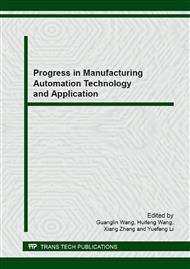p.3
p.8
p.12
p.16
p.21
p.25
p.30
p.35
p.41
Assisted-Grinding in the Laminated Template Electroforming
Abstract:
Deposit uniformity control is the key in laminated template electroforming and has direct influence on the parts shaping quality and processing cost. Accordingly, this research proposes a Assisted-Grinding pulse electro-deposition technology and designs the device and technology based on the principal. According to experimental method, a number of hard particles (ceramic beads) fill between the electrodes and are propelled by mandrels rotating movement to allow continuous impinging and grinding to the cathode surface, as an effort to instantaneously eliminate boundary effect that is caused by uneven current distribution. In comparison of the finish surface morphology and deposit thickness among the samples obtained respectively by traditional and new ways, the experimental results show that assistant friction could effectively remove the excess sediment and tumor along surface and provide a relatively flat layer with Ra 0.253μm. It shows particles-assisted-grinding has satisfactory practical values and is a novel exploration resolving the technical obstacle in electrodepositing.
Info:
Periodical:
Pages:
21-24
Citation:
Online since:
September 2013
Authors:
Price:
Сopyright:
© 2014 Trans Tech Publications Ltd. All Rights Reserved
Share:
Citation:


